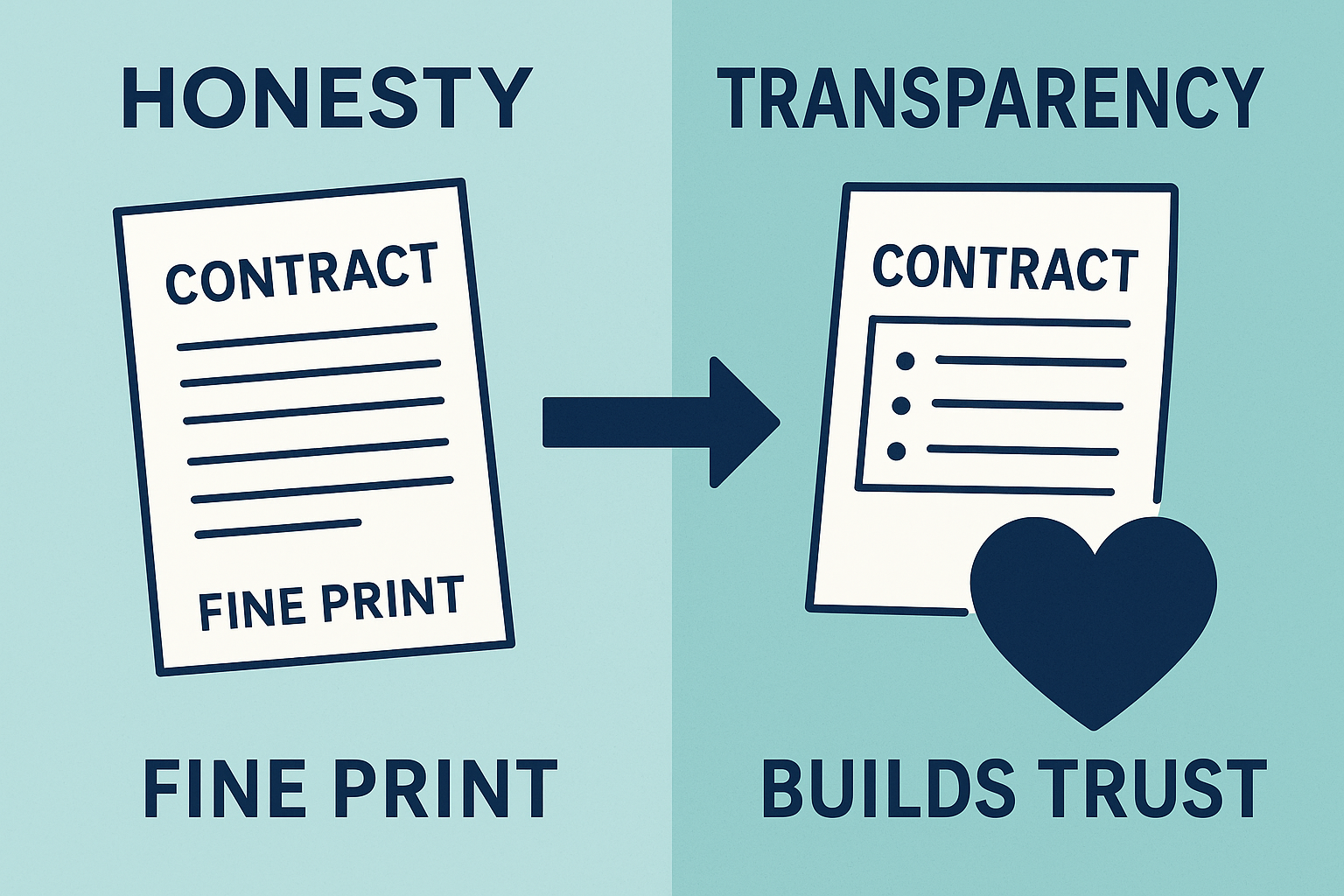Don’t Just Adapt to the Future — Adapt to Now
The legal industry often talks about preparing for the future. But when it comes to how people actually consume information, the future isn’t coming, it’s already here. Clients today live in a world of voice notes, TikToks, on-demand video, and instant messaging. Yet, law firms still rely on 40-page PDFs to communicate vital terms and risks. This disconnect isn’t just outdated, it’s risky. In this post, we challenge the status quo and argue that legal agreements need to be redesigned for the present, not some imagined tomorrow. Using behavioural science, client experience insights, and digital communication trends, we explore how contracts can become clearer, fairer, and more human, and why that shift needs to happen right now.
What this blog contains
- Evolving Client Expectations in the Digital Age
- Behavioral Science: Active Engagement vs Passive Reading
- The PDF Problem: Fear, Friction, and Misunderstanding
- A Clearer Approach: Engaging, Accessible Agreements
-
 i agree: A Solution for Today’s Clients
i agree: A Solution for Today’s Clients
Evolving Client Expectations in the Digital Age
Clients no longer experience information the way legal professionals assume. Today’s consumers – especially younger generations and tech-savvy audiences – live in a world of short videos, voice notes, quick social posts and chat apps. They’re used to TikTok-style clips, smartphone alerts and Instagram stories. In this “digital client journey,” attention spans have shrunk dramatically (one study finds average screen focus under a minute), and people crave concise, engaging formats. Handing such clients a 40-page PDF feels as foreign as a silent movie in the age of Netflix.
Modern legal experience demands more than static prose. These next-generation legal clients expect information delivered in the ways they already communicate: visually and conversationally. If shopping and entertainment have shifted to mobile-video formats, law firm communication should too. Otherwise the firm risks looking outdated and losing clients’ interest before they even read the first line. To keep up, law firms must embrace formats that match this digital appetite – not wait for some distant “future,” but adapt how clients consume info right now.
Behavioral Science: Active Engagement vs Passive Reading
Psychology shows why people won’t sit through page after page of text. The famous “production effect” tells us that information is remembered far better when people actively produce it, rather than just read it silently. Saying something out loud or listening to it makes the memory much more distinct. In practical terms, a client will retain key terms if they hear them explained (or repeat them aloud) rather than passively skimming dense paragraphs. In one study, participants who read words aloud remembered far more than those who just read silently.
Law firms can turn this insight into action by using audio and video tools. For example, short explanatory videos or voice notes that summarize contract sections turn clients into active participants. A narrated summary or an interactive walk-through forces the learner to listen and process, engaging multiple senses. Behavioral science also notes that combining words with visuals dramatically boosts comprehension – for instance, clients may remember ~65% of content paired with images or video, compared to only ~10% from text alone. So replacing text with short animations or charts isn’t just flashy; it aligns with how memory works.
In short, making clients “produce” information (even by just watching a video or listening to an audio clip) taps into their brain’s natural learning channels. This active engagement boosts understanding and retention. The implication for contracts: spoken summaries, interactive checklists, or even prompts for the client to explain a key point back are far more effective than static text alone. By respecting how people learn best, firms can dramatically improve contract comprehension.
The PDF Problem: Fear, Friction, and Misunderstanding
Traditional contracts are simply not designed for today’s learners. Dumping a long PDF on a client creates instant friction. Many people feel overwhelmed or anxious when faced with pages of tiny legalese. In fact, surveys show most users skip the fine print; over 90% of people click “agree” without reading the details. When vital terms are buried in dense text, clients either miss them or feel afraid they’ve missed something. This breeds confusion and fear – clients slow down, ask endless questions, or distrust what they see.
This gap in understanding has real costs. When people don’t fully grasp an agreement, it often backfires in complaints, disputes or regulatory action. The moment a client thinks “I didn’t really know about that fee” or “this is not what I expected,” the relationship is on thin ice. Regulators are noticing too: under rules like the UK’s Consumer Duty, simply posting a long contract isn’t enough. Communications must be “fair, clear and not misleading,” and firms may need to prove customers truly understood key points. A static PDF that clients struggle with can fail those tests. In other words, outdated contract formats elevate legal risk and erode trust.
A Clearer Approach: Engaging, Accessible Agreements
The solution is to break the old mold. Contracts should be delivered in bite-sized, engaging formats that match client preferences. Imagine a legal document broken into short sections, each introduced by a simple plain-English summary or a brief animated explainer. Important terms could have pop-up definitions or short audio explanations. Providing a quick video overview of key obligations – or a chat-style interaction that walks the client through each section – turns the agreement into an interactive experience rather than a hurdle.
Accessible legal documents also mean flexibility in format. Offering clients options (read text, watch a video, or listen to an audio snippet) meets diverse needs. For neurodiverse clients or those with lower literacy, hearing an explanation or seeing an infographic can be far easier than decoding paragraphs of legal jargon. Law firms can build trust by removing barriers: using plain language, bullet points and visual cues to clarify fees, risks and obligations. Research even suggests that clear language can cut help-desk volume substantially (e.g. up to 30% fewer calls in regulated industries), because clients understand more on their own.
All of this adds up to a better contract experience: clients feel informed instead of intimidated. When firms highlight key points, use clear headings and allow clients to replay a short video for any confusing part, understanding naturally improves. Fewer misunderstandings mean fewer disputes and faster sign-offs. In practice, a well-designed digital agreement becomes a tool for risk reduction and loyalty-building – an entirely different legal communication tool than the old PDF that said only “good luck.”
 i agree: A Solution for Today’s Clients
i agree: A Solution for Today’s Clients
![]() i agree is built precisely around these principles, which is why it’s a solution for now rather than some distant innovation. Instead of future-gazing, it meets clients on their turf today: translating legalese into simple pages, checklists and videos. Under the hood, it’s a digital agreements platform that replaces walls of text with clear summaries and optional media explainers. Clients see the key clauses highlighted, can watch or listen to a quick recap, and then record their understanding (for example by voice or video consent). Every step of who saw what and chose it is recorded – far beyond what a signature can do.
i agree is built precisely around these principles, which is why it’s a solution for now rather than some distant innovation. Instead of future-gazing, it meets clients on their turf today: translating legalese into simple pages, checklists and videos. Under the hood, it’s a digital agreements platform that replaces walls of text with clear summaries and optional media explainers. Clients see the key clauses highlighted, can watch or listen to a quick recap, and then record their understanding (for example by voice or video consent). Every step of who saw what and chose it is recorded – far beyond what a signature can do.
This modern approach has immediate benefits. It helps firms prove informed consent and meet compliance standards (for FCA, SRA and beyond). It also cuts risk and cost: with ![]() i agree, fewer clients are surprised by hidden terms, so disputes and complaints drop. Trust goes up because clients recognize the firm is being transparent. In short, modernising agreements with
i agree, fewer clients are surprised by hidden terms, so disputes and complaints drop. Trust goes up because clients recognize the firm is being transparent. In short, modernising agreements with ![]() i agree isn’t innovation for its own sake – it’s practical risk management and an improved client experience that aligns law firms with how people actually communicate and understand information today.
i agree isn’t innovation for its own sake – it’s practical risk management and an improved client experience that aligns law firms with how people actually communicate and understand information today.
Internal Links
- Informed Consent: Understanding Beyond Signatures – i agree: Explains why capturing evidence of comprehension (not just a signature) builds trust and reduces disputes.
- Consumer understanding reduces disputes and complaints – i agree: Shows that clear communication leads to happier clients and far fewer complaints and conflicts.
- The Future of Agreements with Voice and Video Consent – i agree: Describes how using short voice or video clips in contracts feels natural, lowers friction, and improves comprehension.
- 6 Behavioral Science Insights to Improve Business Communication – i agree blog: Highlights psychology findings (like the production effect and dual coding) that can make contracts more memorable and clear.
- The Context Contract – i agree: Discusses how including the missing context (explanations, Q&A) bridges gaps in understanding and prevents “we said, they said” disputes.
External Links
- Reading information aloud improves memory of materials – ScienceDaily (University of Waterloo, 2017): Summary of a study on the “production effect” showing that reading aloud and hearing yourself significantly boosts retention.
- Are attention spans getting shorter (and does it matter)? – CBS News (David Pogue, 2023): Reports that average attention on screens is now under a minute, with warnings that short attention spans cause more errors and stress.
- Teaching Gen Z: The impact of TikTok-style video learning – Learning Technologies (2025): Article on how younger learners expect short-form, video-based learning and how large text blocks overload their cognitive load.
- 7 Stats: Why Video Instructions Beat Text – Speach.me (2024): Industry blog that cites research like “viewers retain 95% of a video’s message vs 10% when reading text”, emphasizing the memory advantage of video.
- Most Online Terms of Service Are Incomprehensible to Adults – VICE (2019): Reports that >99% of 500 popular site contracts were too complex for average readers, with most requiring 14+ years of education, highlighting the gap between legal writing and readability.
- Informed Consent: Reading and Understanding Are Not the Same – Applied Clinical Trials (2004): Notes that “average Americans read at an eighth-grade level,” yet complex consent forms are written much higher, illustrating why simplifying language improves comprehension.




